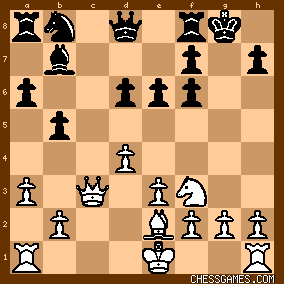| Oct-08-11 | | DrMAL: Vitolinsh-Adorjan gambit with 6...b5 was a move suggested in present Akobian vs. CG Poll game being played. The line chosen here starting with 8.Bg5 in response to 7...c6 shows drawback to this gambit, basically refuting it. For example, after 12...gxf6 a likely position, white has several moves to take advantage of flaws in this gambit as computer shows.

click for larger view Houdini_20_x64: 29/66 7:16:02 213,724,219,483
+0.36 13.a4 bxa4 14.0-0 Nd7 15.Rxa4 Nb6 16.Ra5 Rc8
+0.34 13.0-0 Nc6 14.e4 d5 15.e5 fxe5 16.Nxe5 Nxe5
+0.27 13.Nd2 Nc6 14.0-0 Ne7 15.a4 Qb6 16.Qb4 Rfb8
+0.19 13.Qd2 Nc6 14.0-0 Na5 15.Qb4 Nc6 16.Qb3 Na5
6...b5 was intended to sharpen position and after 7...c6 white can choose from a number of moves that maintain sharpness but also lead to lines that give black a good game. For example, 8.e3 cxb5 9.Bxb5 Ne4 10.Qb3 Ba6 and black is doing nicely where 11.Bxa6 Qa5+ gives clear advantage to black. However, 8.Bg5 is very strong move that allows white to remove sharpness with long term advantage in resulting positional game. Diagram above and evals with starting lines on move 13 above show this, but in actual game white did not follow through with sufficient accuracy for high chance of win. Opening theory today is all about this, it is defined by demonstration of nuances turned into novelties. TNs usually involve creating sharper positions that are won by inaccuracies of opponents play less familiar to them. Then, as they are better understood they are often refuted, this is the case for 6...b5 gambit in game it can give greater winning chances at one time or level, but at later time and/or higher level it can be refuted and end up producing worse results than more usual moves/lines. |





